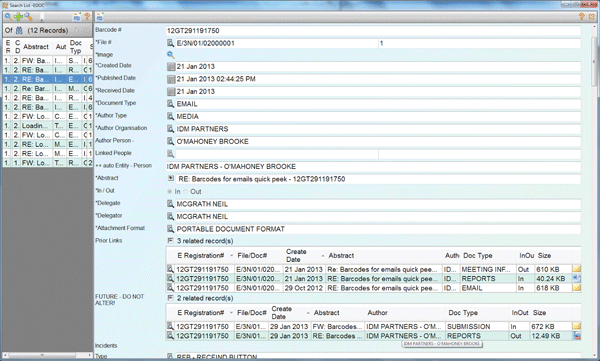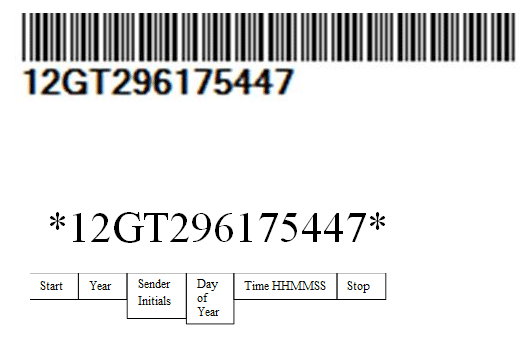Can barcodes end email confusion?

A previous edition of Image & Data Manager magazine (page 22 Nov/Dec 2012 issue) asked “Can technology classify records better than a human”. Records Management Officer Neil McGrath has developed an approach that integrates barcode labelling of emails within an EDRMS to assist in tracking email conversations and reducing duplication while providing improved aggregation and linking.
Neil McGrath is Records Management Officer at Canegrowers, the peak body that represents around 80% of Australia's 4000 sugarcane growers, with 14 offices throughout Queensland.
In days past with hard copy correspondence it was routine to include a reference number in your letter so when a reply was returned hopefully this reference number would be quoted to allow for simple matching and filing of corresponding items.
Today with the fast pace of email that luxury no longer exists. When a reply to email correspondence is received you not only get the returned reply but also your original item as well.
Depending upon the format of the email it may have one or many attachments, however clicking the reply button strips off the attachment and a conversation can continue for quite some time.
Prior to electronic mail, correspondence was sent inside an envelope which had very little practical information and was discarded. Now email is the envelope as well as sometimes the actual correspondence itself. It can also carry associated information as attachments and include other email which may have several attachments or even worse multiple nested levels.
Records Managers have no say over how the email they are asked to capture has been formed. They require many tools to work with it whilst retaining it in its native format.
Traditional thinking has been to electronically capture or (heaven forbid) print out each inward & outward motion, ebb & flow of an email exchange. I believe it more prudent to maintain a system of significant capture points, such as when attachments are sent out, attachments returned, when new players become involved and forked dealings.
For this concept to work effectively it must be applied at either the initialisation point, or what I term ‘First Point of Contact’ for the organisation. This way incoming email received by multiple recipients would all carry the same reference/barcode number.
At Canegrowers this is being accomplished by having the records manager (myself) keep track of emails & apply the same barcode number to the newest part of any particular conversation, discarding previous duplicated parts prior to capture into the EDRMS. This approach works fine within a small organisation with only one records manager. Once the method has been accepted it will be open to users to apply the barcodes.

This view of an electronic document held in our RecFind EDRMS shows links to the significant capture points. When viewed from a particular point in time you can see what has been linked both in the past and the future.
Implementation hurdles that were overcome included:
• Firstly, the need to allow barcodes to survive across organisational boundaries and passing through many points where attachments are stripped;
• Removing font dependence; and
• Persisting within different email formats and remain able to be reconstituted
Presently the barcode is appended to an email on the fly via an Outlook macro. However since Outlook 2007, macros now trigger security notifications so there is in train the initial stage of designing a specific Outlook Add-In to overcome this constraint.
The macro code calls a small free barcode library which then returns a correctly formatted graphical barcode into the current email as well as embedding a small piece of text inside the email. This text will persist should either the sender, recipient or any intermediary process remove the barcode, allowing the graphical barcode to be reconstituted.
This same reference number is also appended to the subject line of the email which in my case further automates later capture processes. The barcode is placed into the top RH corner of the email and as the exchange continues, keeps floating to the head of the email.
The benefit of this is that should an email be printed and subsequently notated, any document scanning will automatically apply this number to the captured electronic file allowing easy match up with data already captured using this same reference number.
The same barcode/reference number is appended to most of the correspondence (attachments) contained within that particular email, through a number of different processes dependent upon the type of attachment. Some record-keeping purists may argue that altering the content of an email message is sacrilege, however I contend this is no different to the manual filing processes of applying either a File / Date / Retention stamp or barcode label to a hardcopy item or removing a report already filed.

Barcode applied to an email
Barcode is King
The barcode number dictates the ID of the electronic document or hardcopy item and whilst the barcodes are sequential, the order of entering them into the EDRMS then does not require any particular pattern.
At Canegrowers we use the RecFind EDRMS for electronic as well as for hardcopy recordkeeping.
When an email is stored in RecFind using the RecFind Button AddOn it automatically fills in a whole host of metadata including placing the subject line with this barcode number straight into the abstract. This then allows direct copy and paste reducing keystrokes and possible errors as this same barcode/reference number then becomes the reference number (ID) of the electronic document.
Within the EDRMS this ID is not required to be unique which allows for the same conversation item to utilise this same reference number at the various capture points.
For our hardcopy correspondence we apply a barcode sticker prior to scanning & capture, although this process uses a different numbering format more akin to standard RM practices. Different barcodes can be applied to any forked conversations to other players who may have been involved but subsequently relinquished the jousting back to the main combatants. Again these can easily be linked as they already contain the previous reference number within the subject line in their earlier transactions
Some may ask why barcodes provide a better way to manage and store email as records, instead of just storing everything and searching by metadata.
When applied correctly from the conversation start, the barcode number is automatically applied and will remain intact with that particular item until destruction, it is not subject to interpretation and with attachments of a particular item bearing the exact same number any search will find all instances of any particular reference number. This allows for managing the entire conversation as one. Whereas metadata will fluctuate dependant on capture point especially when multiple participants are involved and the subject line is changed which occurs frequently. It will also point to where a particular fork may have strayed from the main conversation as normally the subject may change at this point.
The barcode also indicates that an item has been marked for capture and the status can be quickly checked
Barcodes also help reduce duplication of attachments with the same data being constantly saved over & over again as occurs with traditional methods.
Another macro creates a listing of all attachments inside a particular email message which is captured into the abstract. This then allows the user to quickly search the EDRMS for an item of the same name and then compare the properties of any similar named items.
We provide a link to prior items already received under a specific barcode number and using the barcode number the search for prior items can be achieved extremely quickly. Should an item already be captured we then create a pointer (link) to that item. This allows discarding some if not all of the attachments. Of course this requires a good knowledge of what has already been captured using the attachment listing information with saved properties. Each email and associated attachment(s) carry the same unique barcode. These individual barcode numbers are then able to be linked within RecFind to provide an end to end view. Past & Future links – see screen dump
Notation of all alterations are stated in the abstract with linked reference numbers copied and pasted again reducing keystroke and data entry errors.
Sample Attachment listing
Listed Attachments: -
2012 HAULAGE LOADING GUIDELINES COVER V6.PDF - (643968) - (28/10/2012 11:43:30 PM)
2012 HAULAGE LOADING GUIDELINES.DOCX - (3028686) - (11/02/2013 5:27:06 AM)
IMAGE001.PNG - (11493) - (11/02/2013 5:28:25 AM)
These processes rely on full access to Outlook and cannot be initiated on mobile devices without the full version of Outlook. With the emergence of tablets now running the full Windows Operating System this should now become less of an impediment. (The barcode will persist on mobile devices, it just cannot be started from there.)
Barcode format

I have settled on the 3 of 9 barcode format for my barcodes as this matches up with the hardcopy barcode scanning process delivered as part of our RecFind set up, this allows a corresponding human readable number to be seen alongside the actual graphical barcode, not available in QR codes and some other formats.
I have created my barcode numbers along the following format maintaining a consistent 15 character length.
• First 2 digits represent the year
• Next 2 sender initials
• Next 3 day of the year
• Final 6 timestamp in HHMMSS - 24 hour format.
Such a numbering format scheme with the assistance of wildcard characters quickly allows for all items for a particular Year, Person or timeframe to be found and or linked
Although this design does not make the barcode absolutely unique in that it is possible that multiple people with the same two initials could send an email at exactly the same second.
The possibility of having identical reference numbers is more likely in larger organisations, for me this is negligible and likely that the subject lines would differ sufficiently to be easily discernible.
The coding in such circumstances may require changes, perhaps an employee number or other code would be captured and inserted. This would require a whole of organisation approach or the timestamp could be extended down to microseconds although again still not guaranteeing absolute uniqueness
The 3 of 9 format specifies each character requires 5 bars as well as stop & start characters. Extending the length of the code may necessitate one of the other barcode formats to be used, as the physical barcode length will certainly become an issue for anything longer than I have advised above.
This system is also used to track an individual case by quickly appending the same reference number to all pieces of correspondence. A quick metadata search will provide the case reference number which is then copied and pasted into the barcode generation macro providing minimal chance of error due to the fact the reference number is never typed, it is always copied & pasted.
I am using this process for both our crop & general insurance dealings in which the same reference is applied to all correspondence for that particular year.
We also utilise some code that lists the contents of ZIP files which similar to the attachment listing described elsewhere is also captured into the abstract. We are working on creating a list of timestamps within an email conversation which would quickly allow comparison of which parts of a conversation are already included.
